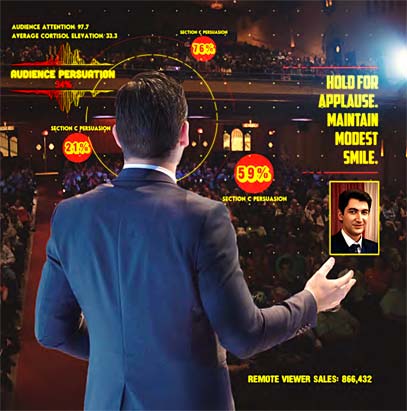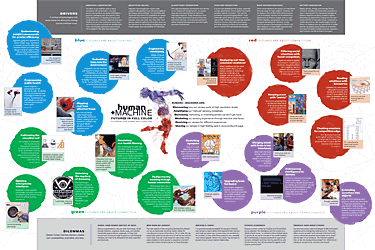Future Now
The IFTF Blog
The Red Competition: A Human+Machine Futures Scenario
"Mmm ... this feels good," Andrew murmured inaudibly. Throngs of adoring fans were hanging on his every word. The crowd cheered as Andrew lifted his arms to put emphasis on his final point: how to order the new edition of his best-selling application, Winning FriendsTM.
 Andrew smiled broadly and pumped his fist into the air. The roars from the audience were deafening.
Andrew smiled broadly and pumped his fist into the air. The roars from the audience were deafening.
Taking advantage of this momentary distraction, Andrew glanced at his hands. His thin, black, leatherette CrowdmoteTM gloves sparkled and shone, indicating—from the decibel measurement of the screaming people and an ambient scan of heart rate, body temperature, and testosterone—that these guys were ready to put down any amount of money that Andrew asked for. They were eating out of his sparkly, gloved hand.
Andrew and his Winning FriendsTM team had perfected the art of the sell. Rather than relying on the sex appeal of beautiful women to push product, their process was methodical and quantitative. Auditorium-wide computer vision cams measured and analyzed postural changes, and smart noses hung from the rafters measured hormones excreted through sweat. A quick analysis of this typically self-conscious, male audience told Andrew’s team something quite palatable. Their competitive instincts spiked in the presence of highly masculine and attractive men, which—in turn—made them more likely to make a big purchase with less indecision than would the arousal incited by women. And, for the few women in the audience, having hunky dudes asking for hand-auth payments had, likewise, proven to be quite effective.
Another day, another play
Andrew held the largest repository of emotionally guided interactions known to humans. “We know what to say to every individual at any given moment. When you wear EmpatheyesTM, you’ll instantly identify the person you’re looking at, you’ll know all about their social networks, their real-time shares, and their socio-emotional mapping. You’ll get continuous feedback as their gestures, postures, and micro-expressions change in response to what you say and what you do.” Andrew had used the product enough while selling it that, just by looking at someone, he could size them up and know how to pitch to them—what tone of voice to use, how close to stand, when to look or not look into the eyes. People are so predictable.
You feel me?
Despite advances in consumer medicine, no one had yet hit on a commercially viable hormone sensor. That is, until Andrew and his team had released TouchtocinTM—fingertip pads for sensing cortisol, estrogen, progesterone, testosterone, and glucose. The pads revealed not only the emotional state of a target but also the biological state—whether the person was stressed, whether he or she needed to eat, what proverbial time of the month it was for him or her. All these questions could be answered with TouchtocinTM, opening the doors to a new world of consumer knowledge. Imagine the possibilities!
Andrew had come a long way from his lonely days living in a studio apartment with four roommates who barely knew him. He recalled browsing IRCs and thinking about the convergence of online and IRL. Then, his breakthrough: friendship is just an experience design problem. He spent the next five years developing the tools he needed to solve this problem, then deployed them with military precision. Now he has a billion friends—but what an unexpected kind of friendship it turned out to be.
A scenario about competition in human+machine futures
 This scenario is one of the four possibilities we imagined in our new map, Human+Machine Futures in Full Color: Extending Our Senses and Ourselves, the first in our 2015 Technology Horizons program’s series of projects about Human+Machine Futures—the blurring lines between human and machine, natural and artificial. The map forecasts how emerging technology is creating what are today vast and unknown territories of human sensory experience. Rooted in the color-based systems mythology tool IFTF developed in 2014, the map’s forecasts, scenarios, and artifacts from the future were created to help us imagine how the future of human-machine symbiosis will be colored by our priorities, concerns, and values.
This scenario is one of the four possibilities we imagined in our new map, Human+Machine Futures in Full Color: Extending Our Senses and Ourselves, the first in our 2015 Technology Horizons program’s series of projects about Human+Machine Futures—the blurring lines between human and machine, natural and artificial. The map forecasts how emerging technology is creating what are today vast and unknown territories of human sensory experience. Rooted in the color-based systems mythology tool IFTF developed in 2014, the map’s forecasts, scenarios, and artifacts from the future were created to help us imagine how the future of human-machine symbiosis will be colored by our priorities, concerns, and values.
The red scenario and artifact from the future are about competition. In them, social interaction is seen as a game of winners and losers. Like the blue scenario, it attempts to quantify everything, but rather than look at this data impartially, red uses it to pass judgment. In this scenario, all social interaction is transactional, whether it’s directly about selling an actual product or not. We see this mentality at work in the interface, as well, which is bold and assertive, clearly trying to win the user’s attention in a world of stiff competition.
Signals of this future from today
While the technologies we see in the scenario mostly do not exist in such advanced form today, several signals—actual projects, products or initiatives from today—that point to future change informed this scenario.
- Augmented reality, digital information overlaid onto the real world through a viewing device such as a phone or potentially some form of smart glasses or contacts, has gotten a lot of attention in recent years. While many of the early experiments are centered on novelty or marketing, this scenario posits that it could be used to learn about other people.
- Already today, we have many technologies that generate sensitive information about people just from video recording them. For instance, the <pulse> app allows you to fix your smart phone’s camera on a person and the app will estimate their heart and breathing rates from fluctuations in skin color that are nearly imperceptible to the human eye. And analysis tools and services that detect micro expressions in people’s faces to uncover granular information about their emotional state are getting more sophisticated all the time. But how far could this go? In this scenario, the Winning Friends system uses real-time hormonal analysis as an even more powerful, and invasive, way to learn about people’s physical and emotional states. While it’s certainly not real-time and requires direct contact, researchers at Aneeve Nanotechnologies are today working to develop low-cost sensors that can be made at home with an inkjet printer and carbon-nanotube ink. They are meant to allow women to regularly test fluctuations in their hormone levels just as diabetics test fluctuations in their insulin levels. Like with any technology, there are varied applications. They could be used to increase empathy or self-knowledge. But a “red” usage of this technology would be to turn social interaction into a game to be won or lost.
- Gamification holds of a lot of promise for everything from learning to health and well-being management. However, the idea of “gamifying” our social lives should provoke healthy skepticism. Researchers have just started to ask questions about whether we can become “addicted” to video games. Which may not be surprising when you consider that games that account for 40 percent of the time people worldwide spend on smartphones or tablets. Granted, we don’t need technology to do this—gaming addiction has existed since the advent of gambling. However, it’s worth being cautious of the amplifying effects technology can have on these existing behaviors and issues. Already, we accumulate “likes,” and retweets on social media. In a red future, what happens when we are able to quantify the smiles or skeptical raised eyebrows we provoke in other people? What happens when we quantify the physiological reactions that other people have to us?
- If this world troubles you, it’s likely you aren’t the only one. While it is likely there will be demand for these services, it is also likely there will be a substantial backlash. Today, we see countless efforts to ensure digital privacy, from VPNs to cell phone RF signal blockers/jammers and even makeup tutorials that help viewers confuse facial recognition software. While usage of such tools isn’t totally mainstream, in a red future like this, the reaction is likely to be as aggressive as the privacy-invading tech it is responding to.
What is the color of the future you want to design?
This scenario represents something of an extreme; it’s almost exclusively “red.” The actual future will have some of each “color,” but the exact mix at play in any given location will be determined by the values and priorities of the people making the future today. Looking at each color in isolation, though, helps us think through what those values and priorities are, and how they might manifest if carried further into the future. Over the next several weeks, we’ll post the two remaining scenarios and artifacts, painting a picture of the full color spectrum of emerging technologies shaping the human-machine relationship, in the hopes that it helps you design for the future in which you’d like to live.

This post is from one of Technology Horizons 2015 forecast maps, Humans+Machine Futures in Full Color: Extending Our Senses and Ourselves, which explores how advances in technology will create new forms of human-machine symbiosis, expanding and even redefining what we can do with our five senses.
Also see:
Curious about the Technology Horizons program?
- Follow the forecasts at @iftf
- Find out more about the program
- Check out previous years' Technology Horizons research
- Contact Sean Ness (sness@iftf.org)



